Documenting successes and share experiences towards
Three years into implementation, the Early Warnings for All initiative has brought the world closer to a reality in which everyone on Earth is protected from hazardous events through life-saving early warning systems. When the initiative was launched by the United Nations Secretary-General Antonio Guterres in 2022, the lead actors - WMO, the United Nations Office for Disaster Risk Reduction (UNDRR), the International Telecommunication Union (ITU) and the International Federation of Red Cross and Red Crescent Societies (IFRC) were chosen to build on decades of work by governments, communities and international partners to strengthen the four pillars for implementation of successful early warning systems. As countries are progressing in their efforts to develop early warning systems, partners are working to document successes and share experiences that underline the value of these systems worldwide.
The Sendai Framework for Disaster Risk Reduction 2015-2030 defines the global target for early warnings and links it to the indicators of the Sustainable Development Goals (SDG). The Early Warnings for All Implementation Toolkit, developed by the lead actors, has dedicated tools, indicators and a maturity index to measure progress towards the 2027 goal. Funding agencies, development partners and regional organizations also have more robust measures of success.
This article presents the perspective of WMO, UNDRR, two directors of National Meteorological and Hydrological Services (NMHSs) from countries with different resources and technologies available to them, China and Madagascar, the Chair of the board of the Climate Risk and Early Warning Systems (CREWS) funding mechanism, and a community perspective from a country in conflict, Sudan. Each contributor answers three questions:
- What does success look like from their perspective?
- How do they measure it?
- What transformational changes does it require?
There is considerable convergence in answers on what success is and how to measure it, with noteworthy variations in perspective from each institution. Ultimately, early warnings are issued as a public service to inform life-saving early action - the responsibility of national and local authorities and institutions. Thus, this community of users is best placed to measure the effectiveness of early warnings. Governments are advancing efforts to increase the comprehensiveness of their systems, and some, such as China, are stepping up to the challenge and defining good practices for others to follow. Leading up to 2027, the Bulletin will share success stories from the front line that will show how early warning systems are making a difference in people's lives. A common understanding of what success means is a prerequisite to measure impact and tell those stories.
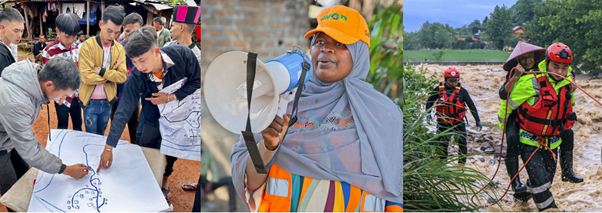
International Perspective - WMO
Answered by WMO Deputy Secretary-General Ko Barrett
"WMO and the other Early Warnings for All lead actors cannot "go it alone". Success can only be achieved through partnerships, working together..."
What does success look like from the perspective of WMO?
WMO aims to implement effective early warning that enables anticipatory action aimed at saving lives, livelihoods and property, reducing economic losses, and strengthening societal resilience against natural hazards.
WMO envisions success in the Early Warning for All initiative as substantial, measurable progress, by 2027, toward ensuring that everyone at risk from natural hazards - weather, climate or water-related events - receives early warnings of the pending danger that they can understand and act on.
These are the WMO benchmarks of success:
- The effective integration of international, regional and national systems for the observation, collection, processing and dissemination of meteorological, hydrological and all other related Earth system data.
- Whether NMHSs are lawfully mandated and resourced as the operational authorities for hazard detection, forecasting and communication, especially the issuance of early warnings, as a matter of national security for the public good.
- That Earth system science continues to develop and drive understanding of hazards and related risks and to inform effective early warning systems that save lives and livelihoods and support sustainable development and socioeconomic well-being.
- The closing of observation, forecasting and dissemination capacity gaps in Least Developed Countries and Small Island Developing States.
This underlines that the responsibility and accountability for early warning systems, and therefore for the success of the initiative, lies with multiple international, regional, national, and local institutions. WMO and the other Early Warnings for All lead actors cannot "go it alone". Success can only be achieved through partnerships, working together, and with further investments at the national level and through funding mechanisms such as CREWS, the Green Climate Fund (GCF), and the Systematic Observations Financing Facility (SOFF).
How does WMO measure success?
WMO leads monitoring and evaluation efforts within the Early Warnings for All initiative and has a robust multilevel monitoring and evaluation framework to track progress. This includes both system-level readiness and community-level outcomes.
Key measurement tools include:
- The Early Warnings for All Maturity Index, which tracks national progress across the four implementation pillars, as well as interpillar domains, drawing on structured national assessments.
- Capacity Assessment are conducted in the Early Warning for All priority countries using standardized tools to evaluate forecasting capabilities, institutional coordination, and foundational capacities, such as compliance with the Global Basic Observation Network (GBON).
- The Sendai Framework Monitor is used to track institutionalization and the population covered by Multi-Hazard Early Warning Systems (MHEWS) at the global level, as reported by countries.
- Project-level result frameworks are used, especially under CREWS, GCF and SOFF initiatives, to capture progress in building technical capacity, improving service delivery, and expanding end-user reach.
WMO supports countries to institutionalize these tools and embedding them into national systems and reporting frameworks. This ensures national ownership of monitoring processes and strengthens accountability across ministries and sectors.
So far, 17 of the Early Warnings for All priority countries have developed, or are developing, national roadmaps and/or implementation plans for early warning systems. These provide structured baselines for measuring country-level progress. WMO's six Regional Associations have also adopted coordination mechanisms to align national implementation with regional priorities and global Early Warning for All targets.
Progress is reported through:
- The Global Status Report on MHEWS , jointly published with UNDRR.
- A dedicated Pillar II report, to be produced for the first time in 2025, highlighting implementation progress across WMO activities.
- The Early Warnings for All Dashboards that will visualize maturity levels, milestones and gaps is under development.
- The WMO State of the Global Climate Reports and regional diagnostics, which highlight real-world impact.
What transformational changes are required?
Achieving the ambitious 2027 goal for Early Warning for All requires three key transformations:
- Institutional transformation: Legislative recognition of NMHSs as the national authority for data collection, forecasting and early warnings related to natural hazards provides the basis for their inclusion and engagement in national planning and financing processes. This is essential for the sustainable operation of the NMHSs and to enable participation in cross-sectoral coordination with emergency coordination authorities, among others.
- Data and digital transformation: Data gaps, especially in observation networks and data sharing must be closed. WMO supports its Members in achieving the standards agreed under GBON, to use WMO Information System (WIS2.0) for data sharing, and to improve forecasting capacity by using data and forecasts from its regional centres, including impact-based systems.
- Risk driven warning and climate services: risk information based on the science of hazards and vulnerability needs to drive warning and climate services focused on the impact of events to inform early action.
- Localization and community-centred design: Warnings must be understandable, trusted, and actionable at the community level. National roadmaps and regional mechanisms must prioritize inclusive design, co-production of services and feedback systems for continuous learning.
This transformation demands sustained leadership, investment and coordination. It is the role of WMO to provide scientific, technical and institutional scaffolding to enable national governments supported by regional and global partners to build, own and sustain effective Early Warning Systems for All.
 wmo |
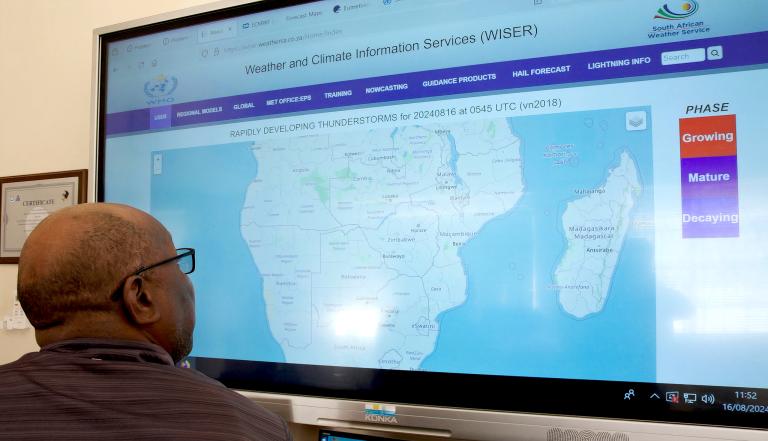 WMO |
|---|
International Perspective - UNDRR
Answered by Paola Albrito, Director, UNDRR
"Universal early warning systems are not just a technical solution - they are a matter of equity, resilience and human rights."
What does success look like from the perspective of UNDRR?
Early warning systems save lives. Countries with comprehensive systems experience six to eight times fewer disaster-related deaths than those without. Yet, millions remain unprotected due to limited coverage, both globally and within nations.
To close this gap, the United Nations SecretaryGeneral has called for universal early warning systems, in line with Target G of the Sendai Framework for Disaster Risk Reduction. Success for us means ensuring that everyone, everywhere, can anticipate hazards and act in time.
This is especially vital for at-risk groups, such as women, persons with disabilities and older persons, who are disproportionately affected by disasters. The needs of Small Island Developing States (SIDS) and Least Developed Countries (LDCs), which face heightened risks and have limited resources, must be prioritized.
Universal early warning systems are not just a technical solution - they are a matter of equity, resilience and human rights. No one should be left behind in the face of growing climate and disaster threats.
How does UNDRR measure success?
As the global community advances toward universal early warning coverage, tracking progress is essential. We measure success across three key criteria: coverage, comprehensiveness and effectiveness.
Coverage is the availability and accessibility of early warning systems.
Comprehensiveness is assessed through progress across four foundational pillars: disaster risk knowledge, observation and monitoring, warning dissemination and communication and preparedness to respond.
Effectiveness is evaluated by the reduction in disaster impacts and the performance of early warnings across six dimensions: relevance, timeliness, accuracy, accessibility, actionability and responsiveness.
To support this effort, a Maturity Index is being developed as a robust framework to assess the capacity and effectiveness of MHEWS in countries.
Progress is reported through two main products. The first is an online dashboard , which is a central portal for continuous monitoring of global and programmatic indicators. It is currently being upgraded to include country-level snapshots for more granular insights.
The second is the annual report on the Global Status of MHEWS , which in 2025 will release its fourth edition. These reports have established baselines for measuring progress, documented achievements and served as policy guides for overcoming remaining challenges.
Together, these metrics and tools provide a clear picture of where countries stand and what is needed to ensure that early warning systems reach everyone, especially those most at risk.
What transformational changes are required?
Three come to mind: First, to be truly effective, early warning systems must be co-developed and co-owned by the communities and sectors they aim to protect. Participatory approaches build trust, empower users and ensure that early action is tailored to local risks, priorities and capacities. Institutionalizing this shared responsibility is key.
Second, countries must develop sustained domestic financing models. For example, by adopting a "resilience dividends" approach, governments may reinvest a portion of avoided disaster losses into maintaining and expanding early warning systems. Partnerships with the private sector can also further mobilize resources.
Third, there needs to be greater adoption of emerging technologies like Artificial Intelligence (AI) and geospatial imaging. This requires bridging the digital divide and embracing inclusive designs, which build on traditional knowledge and ensure accessibility for all.
Through these changes, we can cement the progress achieved thus far and set the foundation for universal coverage.
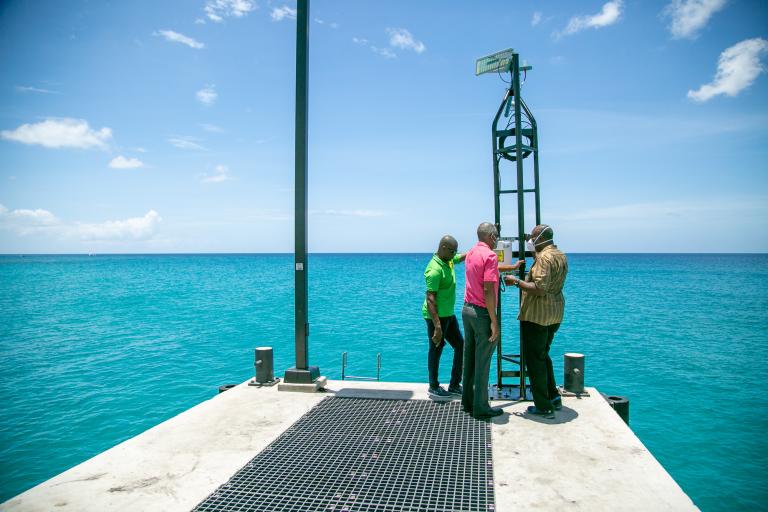 UNDRR, 2022 |
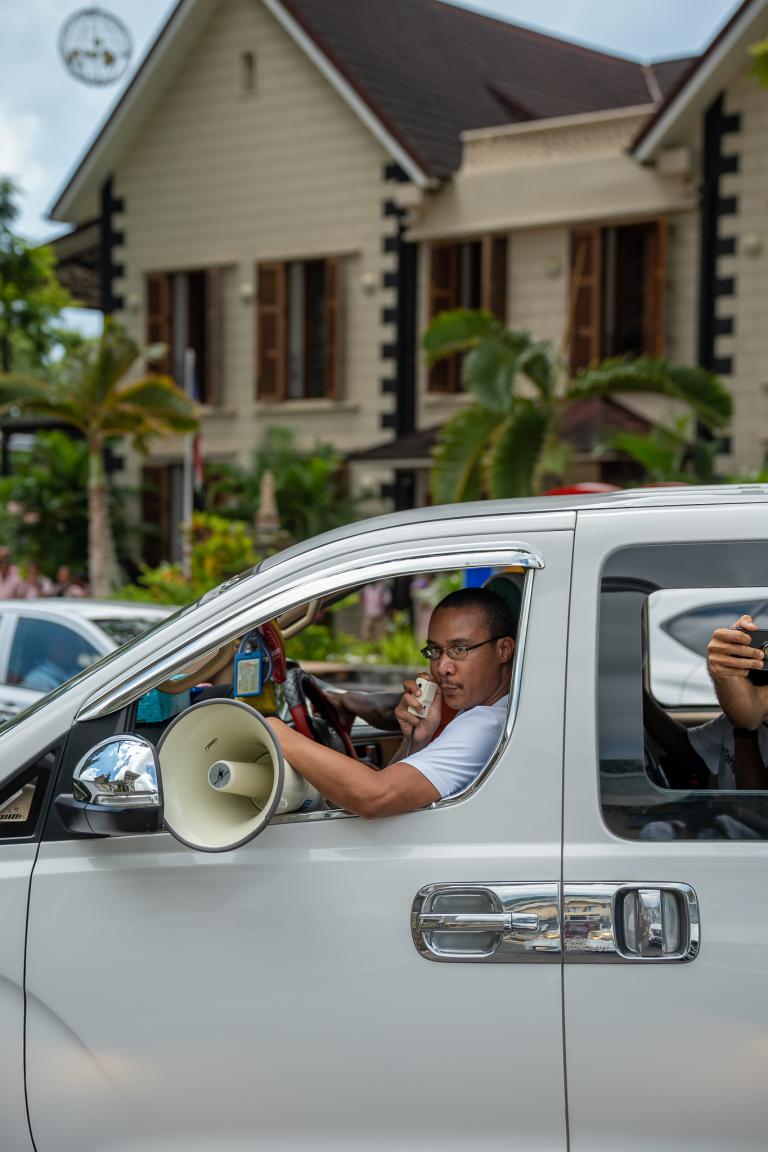 UNDRR, 2023 |
|---|
The financing mechanism perspective - CREWS
Answered by Francis Pigeon, Executive Director, Policy and Partnerships, Environment and Climate Change Canada (ECCC), and Chair of CREWS
"… institutions financing early warning and climate services can push innovation and contribute to the next generation of early warning systems - but most importantly they can help to save lives."
What does success look like from the perspective of CREWS? Success is a world in which everyone - especially those most at risk - is provided with timely, accurate, accessible and actionable early warning and climate services whenever and wherever an extreme event is to occur. Central to this vision is that all people, especially the most vulnerable, will receive early warnings and be able to take action to protect themselves, their loved ones and their livelihoods.
From a financing institution perspective, this will only happen when early warnings adhere to the following criteria:
- people-centred
- gender-responsive
- co-designed with users
- forecasts and warnings include information on all potential hazard and all their potential impacts
- are communicable on all available channels.
However, financing institutions, such as CREWS, need to demonstrate the effectiveness of their financing of early warning and climate services by a reduction in the loss of lives and livelihoods caused by extreme events and climate variability. But loss of life and livelihood alone have limitations as measures of success. One is the fact that trends in loss of life and livelihoods are measured over long time scales - typically decadal - while most financing mechanisms are required to demonstrate their impact over shorter timelines. It can also be challenging to show trends in loss of lives and livelihoods for events that occur infrequently.
CREWS, the sole global financing mechanism dedicated to early warning systems, has therefore established a complementary outcome to the way it measures its results: the number of people with access to early warnings and climate services. This aligns with global early warning targets and the Executive Plan for Early Warnings for All. The notion of "access" puts people at the centre of the quantification of success and can be disaggregated by gender.
However, while a very useful metric, the quantification of access still falls short of measuring the impact of warnings, namely the actions that were taken by people and institutions to minimize losses. Measurement of the latter aspects requires demonstrating results against longer term measurements of loss and damage trends as stated above and/or event specific studies and assessments.
How does CREWS measure success?
Results are hardwired into agreed regional and global goals and targets such as the SDGs, the Sendai Framework and, hopefully soon, the Global Goal on Adaptation. Progress is measured by a limited number of core indicators, aligned with standards set by recognized international institutions, such as UNDRR, WMO, IFRC and ITU, and for which tools and platforms have been developed.
As stated above, CREWS demonstrates its effectiveness by monitoring "access" to early warnings and, over the longer term, by studying trends in the reduction in loss of lives and livelihoods. For example, in each of countries in which it has financed projects, CREWS systematically measures:
- Hazards and extreme events that affect the country in which monitoring, prediction and warning services have been put in place
- The number of communication channels through which warnings are disseminated in the area covered by a prediction service for a given hazard(s)
- The number of warnings that are received, understood and acted upon based on co-produced preparedness and response plans.
CREWS also measures its effectiveness in ensuring that people of different backgrounds and gender, as well as youth, older persons, people with disability, the poor, marginalized, displaced and non-native, are included in the co-production of early warning and climate services so that these are tailored to their needs. Such disaggregated information is measured where possible, so that CREWS can measure the number of services developed with, for example, a gender responsive lens.
CREWS continuously adapts its indicators and methodologies based on practice and learning.
What transformational changes are required?
CREWS recognizes that institutions financing early warning and climate services should contribute to the next generation of early warning systems through innovation, integration, and strategic partnerships.
CREWS continuously seeks to position itself at the forefront of global efforts to modernize early warning systems by advancing co-production and innovation, such as AI-driven predictions and cellular broadcast technology. Innovation goes beyond technology solutions to include modalities for effective financing and scaled-up action fostering integration across key sectors, and deepening collaboration with a diverse range of partners - local, national, regional and global, including the private sector.
Typically, countries with advanced meteorological service capability measure the timeliness and accuracy of their monitoring and predictions, few measure the effectiveness of their warning systems. Specific studies and surveys on the effectiveness of the warnings - in that it provided the right information for timely action to be taken to save lives and protect livelihoods and property - usually only occur following disasters of a certain magnitude or warnings of a given level. That is why CREWS works with countries to strengthen the monitoring of the effectiveness of their national early warning and climate services.
The National Meteorological and Hydrological Service perspective: China Meteorological Administration (CMA)
Answered by Pengxiang WANG, Director General, Zhejiang Meteorological Service, China
"… early warning systems should function as a basic public service-available, reliable, and affordable like water and electricity."
In implementing the Early Warnings for All initiative, China is propelling capacity building, improving relevant mechanisms, reinforcing cooperation with WMO and other United Nations agencies, and sharing expertise and cases with the international community.
By 2027, early warning systems should function as a basic public service - available, reliable and affordable - like water and electricity. Leveraging low-cost AI and shared cloud infrastructure, China aims for multi-hazard early warnings to reach 100% of the population via both digital (5G, mobile apps, flash SMS) and analog (FM radio, community sirens) channels. At least 95% of citizens will be equipped with actionable response knowledge. A coordinated, government-led disaster response system will be in place, with critical infrastructure and institutions, integrating early warnings and climate risk information into operations and investment decisions.
By 2030, early warnings will achieve precise coverage of all vulnerable groups. Direct economic losses from disasters will be reduced by at least 40% compared to 2020. Governments will provide leadership and regulation, industries will adopt risk-informed standards, and communities will ensure last-mile delivery - establishing a trusted, visible, and accessible safety net. High-resolution early warnings will be recognized as global public goods.
How does CMA measure success?
Located on China's southeast coast, Zhejiang is highly vulnerable to meteorological hazards such as rainstorms, heatwaves, typhoons, floods and severe local convective weather. As a densely populated economic powerhouse, the region faces amplified disaster impacts. Zhejiang has become a key pilot area for CMA to develop scalable and sustainable early warning solutions within the national framework.
The province has pioneered the "Ten Major Systems" framework for comprehensive disaster risk management, covering: organization, forecasting, monitoring, dissemination, contingency planning, joint response, unified dispatch, imminent risk avoidance, risk management, and public education.
Measurement and impact assessment are structured across four key areas:
- Operational Capacity: By 2027, an AI-powered "Meteorological Brain" will support real-time decisions across 12 departments, reducing emergency response times to under 15 minutes. By 2030, the system will scale across the Yangtze River Delta, establishing a regional defense network.
- Indicators and Reporting: Progress will be tracked using at least 12 performance indicators, including warning coverage, lead time, emergency plan activation, and response efficiency. Results will be reported nationally and through international platforms such as WMO and UNDRR.
- Data and Interoperability: Zhejiang targets 40% integration of international datasets by 2027 and aims to lead the development of two international data interface standards by 2030, aligned with the WMO Unified Data Policy. Multilingual warning products will also be developed.
- Community Engagement: With 98.2% community coverage, it aims to reach 95% public awareness by 2027 and launch a provincial early warning literacy certification system by 2030. Risk visualization and AI-driven defense tools will help reduce disaster losses by 50%.
What transformational changes are required?
Achieving success under EW4All demands transformative change across three key areas:
- Technology: Affordable and specialized AI tools are critical to disaster risk reduction. AI's capacity to rapidly synthesize risk information can support timely, localized early warning decisions and actionable recommendations. Generative AI can also improve data integration, downscaling, and fill observational gaps using satellite and model data. High-resolution forecasting systems (1-km scale, 10 minute updates) will significantly improve accuracy.
- Policy and Investment Linkages: A strategic policy cycle - "Early Warning Disaster Prevention Policy Investment Policy Quantitative Assessment" - will embed early warning systems into longterm planning and unlock sustainable climate finance.
- System Design: Scalable, cloud-based systems and modular multi-hazard toolkits will ensure flexibility. Bridging the "first mile" requires capacity building; securing the "last mile" depends on effective interagency coordination and community engagement. Cross-border collaboration and harmonized warning protocols will strengthen regional resilience.
These shifts will turn forecasts into people-centred, life-saving services.
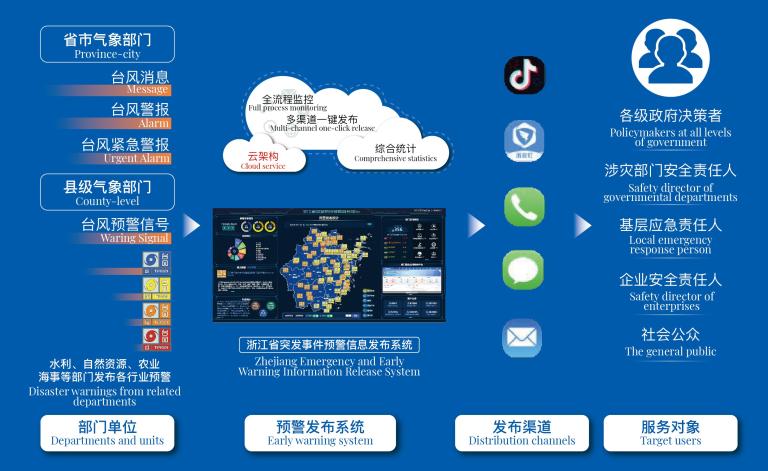 CMA |
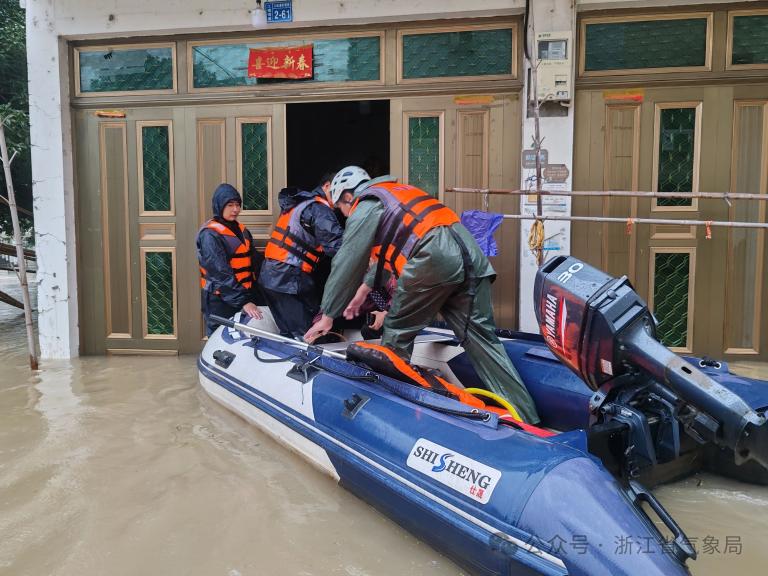 CMA |
|---|
The National Meteorological and Hydrological Service perspective - Météo Madagascar
Answered by Luc Yannick Andréas Randriamarolaza (PhD), Director General, Météo Madagascar, Ministry of Transport and Meteorology, Permanent Representative of Madagascar to the World Meteorological Organization
"Météo Madagascar is strengthening its role as a central actor in disaster risk reduction at the national level, by improving interinstitutional coordination, mandates, and communication channels with civil protection and local authorities."
What does success look like from the perspective of Météo Madagascar?
The vision of the General Directorate of Meteorology (DGM) is that every Malagasy citizen benefits from timely, reliable and actionable alerts against meteorological and climatic hazards by 2027.
The prerequisite for achieving this vision is modernization of the observation infrastructure, improvement of regional data exchange and strengthening of forecasting and staff capacities. This is currently supported by several projects, including the Indian Ocean Commission (IOC)/Green Climate Fund (GCF) Building Regional Resilience through Strengthened Meteorological, Hydrological and Climate Services in the IOC Member Countries project (Hydromet), World Bank Regional Climate Resilience Program for Eastern and Southern Africa (PRRC), CREWS and SOFF.
These initiatives enable the DGM to provide accurate forecasts, to quickly disseminate alerts through multiple channels, and to ensure coordination with civil protection and communities. By 2030, these systems will be fully institutionalized and supported nationwide. The DGM will serve as a national centre of excellence, providing trusted services, fostering innovation, and contributing to regional and global resilience. Communities will systematically act upon warnings, thereby reducing the impacts of disasters and preserving development gains.
How does DGM measure success?
The DGM measures success through a combination of technical, institutional and societal indicators.
From a technical perspective: the availability and functionality of observation networks and of warnings and their lead times will be verifiable with two new tools: WIS2.0 in a Box and ClimWeb (supported by IOC GCF Hydromet and CREWS). The reduction in forecast uncertainty will be verifiable using new technology developed in cooperation with WMO Centres of Excellence (CMA and the Regional Integrated Multi-hazard Early Warning System).
From an institutional perspective: the policy, strategy and legal framework of the DGM are being strengthened with support from CREWS. This will enhance coordination between DGM, civil protection services and local authorities so that clear, up-to-date alert dissemination protocols can be established.
The societal impact: the reach, understanding and use of early warning messages is the measure - how many communities receive alerts, how quickly they respond, and whether disaster-related losses of human lives and livelihoods are reduced.
The DGM will present these impacts through regular national reports, climate risk assessments, and contributions to the regional platforms of the IOC.
At the global level, the results will be incorporated into the Early Warnings for All monitoring frameworks, CREWS and SOFF reports, and the indicators of the SDG on disaster resilience.
The impact will also be highlighted through success stories and case studies demonstrating how improved systems have saved lives and protected vulnerable groups.
What transformational changes are required?
Transformational changes are necessary across all systems, institutions and communities. First, meteorological infrastructure must shift from fragmented and underfunded networks to modern, integrated and sustainably financed observation and forecasting systems. Second, the DGM is strengthening its role as a central actor in disaster risk reduction at the national level, by improving interinstitutional coordination, mandates and communication channels with civil protection and local authorities. Third, the dissemination of early warning is being adapted to become people-centred, inclusive and accessible to last-mile communities, especially vulnerable groups. Finally, the DGM advocates a shift from project-based national funding to sustainable national financing.
Through these initiatives, the DGM aims to become a centre of excellence and a national reference in early warning systems, transforming forecasts into effective early actions that save lives and strengthen resilience.
A community perspective - Sudan Urban Development Think Tank, Resurgence/DARAJA
Answered by Maysoon Badi, Acting Chief Executive Officer, SUDTT
"True transformation requires shifting from top-down, technocratic approaches to people-centred early warning systems…"
What does success look like from the perspective of SUDTT?
For SUDTT and its DARAJA Sudan Emergency Weather and Early Warning Service, success by 2027 means every community in our conflict-affected nation of Sudan has a functional early warning system that people trust and can act upon. Success means women, children, and vulnerable populations are no longer disproportionately impacted by climate disasters because they receive timely, actionable warnings in formats they understand.
By 2027, we envision community-based networks operating effectively alongside our DARAJA partner, the Sudan Meteorological Authority, with local champions trained to distribute warnings via SMS, radio and community meetings.
By 2030, success means comprehensive integration - where traditional knowledge systems complement scientific forecasting, warnings reach 100% of our population, and Sudanese communities have context-specific resilience strategies.
Success extends beyond lives saved to livelihoods protected, as communities leverage early warnings for informed decisions about farming, resource management, and economic activities - despite internal conflict and increasing climate uncertainty.
How do you measure it?
Measuring success in conflict-affected Sudan requires both quantitative metrics and rich qualitative insights. We track fundamental metrics like warning dissemination rates (percentage of population reached), lead time between warnings and events, and most critically, the reduction in loss of lives, livelihoods and property.
However, our experience with DARAJA has taught us that meaningful measurement goes deeper. We assess behavioural change: Do people take protective actions when warnings are issued? Are communications between meteorological services and communities improving? Are community assets being secured before disasters hit?
We measure institutional transformation through the number of formal partnerships between meteorological services and community networks, and through tracking budget allocations to early warning systems at regional and national levels. The sustainability of these systems is measured by community ownership indicators - the number of local champions trained, community-led initiatives established, and indigenous warning systems integrated.
Impact data is presented through multiple channels for different audiences:
- For communities: Visual impact stories shared through community meetings and radio, showcasing local successes and lessons
- For national authorities: Quarterly policy briefs with evidence-based recommendations
- For international partners: Annual impact reports featuring quantitative results alongside human-centred case studies
- For scientific community: Research papers co-authored with community representatives in relevant journals
All measurements use participatory approaches where communities themselves determine success criteria. Our DARAJA "community feedback loops" ensure continuous improvement based on lived experiences. In conflict zones, this human-centred measurement approach is non-negotiable - numbers tell only part of the story when warning systems operate amidst complex humanitarian challenges.
What transformational changes are required?
True transformation requires shifting from top-down, technocratic approaches to people-centred early warning systems. In Sudan's complex context, several shifts are essential:
- First, we need genuine co-production of knowledge. Rather than imposing external systems, meteorological services must work alongside traditional forecasters and community leaders to create warning systems that integrate scientific and indigenous knowledge.
- Second, power dynamics must change. Women and marginalized groups must not only receive warnings but help design and implement the systems for delivering them. At SUDTT, we have observed how women-led warning networks reach further into communities.
- Third, sustainable financing must prioritize local capacity over expensive technology. Small, recurring investments in community networks consistently outperform costly infrastructure that fails without maintenance.
- Finally, we must transform our mindset about conflict zones. Rather than seeing conflict as a barrier to climate action, we must recognize that effective early warning systems can reduce resource competition and actually contribute to peace-building efforts through collaborative climate resilience.
 Port Sudan Co-Design Initiative Sudan Urban Development Think Tank (SUDTT) for DARAJA Sudan, February 2025. Local stakeholders collaborate on weather alert systems during the Port Sudan Co-production Workshop DARAJA |
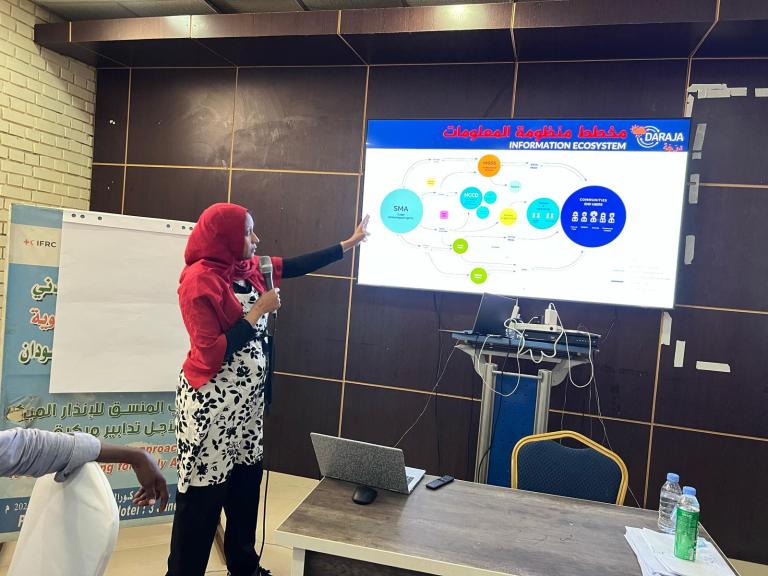 Information Systems Mapping Sudan Urban Development Think Tank (SUDTT) for DARAJA Sudan, February 2025. Dalia Elshafei leads an Information Ecosystem Mapping (IEM) session during the DARAJA Sudan Co-Design DARAJA |
|---|






